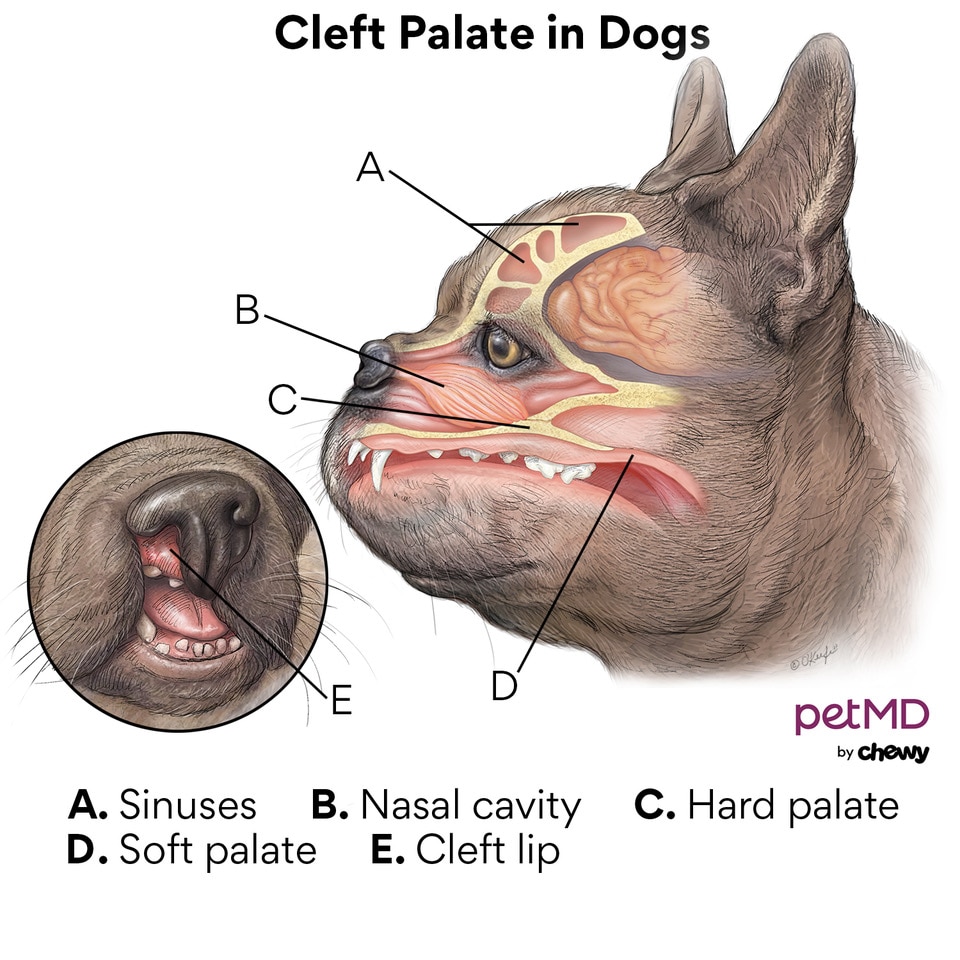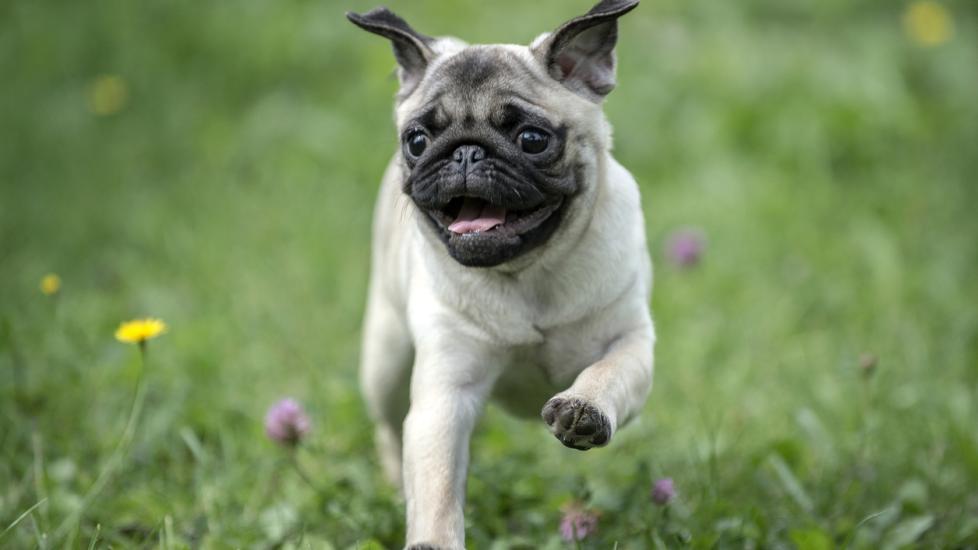Cleft Palate in Dogs
What Is Cleft Palate in Dogs?
The palate is the roof of your dog’s mouth. A cleft palate is an opening along the middle of the palate. This opening can range from small (a few millimeters) to severe (the entire length of the hard and soft palate). This results in a lack of tissue connection between the mouth and nasal passages, creating problems for the dog that include eating, difficulty nursing, and poor growth.

Symptoms of Cleft Palate in Dogs
Symptoms of a cleft palate in dogs can be easy to notice and even visible. Cleft palate in dogs can also create various health issues due to its structure. These symptoms can include:
-
Difficulty nursing: Puppies with a cleft palate are unable to create enough suction when nursing because the oral cavity is open to the nasal cavity. The milk or food the dog does manage to get travels from the mouth to the nose, causing sneezing, nasal discharge, nasal irritation (also known as rhinitis), regurgitation, and gagging.
-
Poor growth: Without the ability to nurse and eat normally, many puppies and dogs with cleft palate do not get proper nutrition and can be lethargic, with a poor rate of growth.
-
Aspiration pneumonia: Breathing in food and water can cause an infection of the lungs. Depending on your dog’s age, this may result in a cough and a fever, then develop into lethargy, difficulty breathing, and possibly death.
-
Facial deformity: Occasionally, dogs with cleft palate will also have a facial deformity, such as cleft lip.
-
Other issues: Though they are not always apparent at first, and depend on the cause of the cleft palate, problems with the inner ear, middle ear, swallowing apparatus, nasal septum, sinuses, and teeth may develop.
Causes of Cleft Palate in Dogs
There are two types of cleft palate in dogs:
Congenital cleft palate is present at birth if the palate fails to fuse properly during days 25-28 of gestation. This can occur for a variety of reasons:
- Genes: Most congenital cleft palates are genetic. Therefore, dogs with any level of cleft palate should be spayed or neutered and not used for breeding purposes.
-
Nutrition: Cleft palates can occur with too much dietary vitamin A or a lack of folic acid during pregnancy.
-
Medications: Most notably, steroids, aspirin, griseofulvin, and some anti-seizure medications during pregnancy can cause cleft palate in puppies.
-
Viruses: If the mother is exposed to certain viruses at a specific time during pregnancy, her puppies may be born with cleft palate.
Acquired cleft palate is a new defect that appears in a previously normal palate. Causes may include:
-
Trauma, such as gunshot injuries, bite wounds, thermal/electric burns, or blunt-force trauma
-
Periodontal disease
-
Foreign bodies in the mouth
-
Cancer
Dog Breeds That Are Prone to Cleft Palate
Purebred dogs, especially brachycephalic breeds (dogs that have short muzzles and flat faces), are more likely to have a cleft palate. Some common brachycephalic breeds predisposed to cleft palates include Boston terriers, Pekingese, Boxers, and Bulldogs. Other breeds that may have congenital cleft palate include:
-
Miniature schnauzers
-
Beagles
-
Cocker spaniels
-
Dachshunds
-
Brittany spaniels
-
Shih tzus
-
Great Pyrenees
-
Nova Scotia duck tolling retrievers
While there may be a genetic link in some of these breeds, there are other causes, and cleft palate can happen to both purebred and non-purebred dogs.
How Veterinarians Diagnose Cleft Palate in Dogs
Most commonly, veterinarians diagnose a cleft palate based on a physical exam, especially in newborn puppies. Older animals may need to be sedated for the exam, which involves a thorough oral inspection, looking for communication between the nasal and oral cavity.
Other abnormalities will be evaluated at this point, paying special attention to the lungs for signs of pneumonia or infection. Your vet may use radiographs to check for abnormalities of the skull, nasal sinuses, membranes, and oral and nasal cavities, as well problems with the inner and middle ear and the teeth.
Vets may use additional imaging techniques, such as MRI and CT. Biopsy and histopathology can be used in cases of acquired cleft palate caused by infections or tumors.
Treatment of Cleft Palate in Dogs
Most cases of congenital and acquired cleft palate require surgical correction by board-certified veterinary dentists and surgeons. A small number of acquired clefts may be able to heal on their own.
Most dogs with cleft palate will require numerous surgeries, but the first is the most important because scar tissue can affect future surgeries. There are a variety of techniques surgeons use depending on the size, location (hard vs. soft palate), and severity of the cleft.
The goal of surgery is to re-establish separate oral and nasal cavities and to reconstruct the nasal cavity floor. This is most commonly done using a flap technique, which involves relocating existing, healthy tissue in the mouth to cover the deformity. Less common surgical strategies include:
-
Stem cells
-
Bone grafts
-
Prostheses
-
Platelet-rich plasma injected at the surgical site
Management of Cleft Palate in Dogs
Newborn puppies with cleft palate commonly require tube-feeding before they are old enough for surgery, usually past 8-12 weeks. This will decrease the chance of aspiration pneumonia and ensure that the puppy receives adequate nutrition. Older dogs should eat small, meatball-sized dog food to decrease the chances of preoperative aspiration pneumonia.
All active infections must be treated before surgery. Dogs with chronic rhinitis or pneumonia may require oral or IV antibiotics before and after surgery. Proper pain medications will also be prescribed in the postoperative period.
Dehiscence—the surgical site breaking down—is a common postsurgical complication. Many surgical sites break open due to tension at the surgery site, lack of space in the mouth, trauma during surgery, and trauma after surgery from eating or chewing. Hard food and chew toys must be avoided for a few weeks after surgery to allow proper wound healing. Dogs should be fed a diet with a thick liquid consistency during this time. Postoperative rechecks should be scheduled with the surgeon, typically at 2 - 4 week intervals.
Dogs that suffer from chronic rhinitis may still have flare-ups and require medications to manage the condition, even after surgery. However, with a successful surgery and a healed palate, the prognosis for these dogs is positive.
Cleft Palate in Dogs FAQs
Can a puppy with cleft palate survive?
A puppy with cleft palate can survive. However, such puppies may have many medical conditions to monitor and treat. Multiple surgeries will likely be required, and the process can be long, difficult, and emotionally challenging.
Is cleft palate hereditary in dogs?
Some types of cleft palates are congenital (present at birth) and have genetic causes.
Can a cleft palate repair itself in dogs?
Small acquired cleft palates (such as those caused by foreign objects in the mouth, infection, or dental issues) can sometimes heal on their own; however, this is rare. Most cleft palates require surgical correction.
Does cleft palate cause any medical issues in dogs if left untreated?
Untreated cleft palate can lead to serious and potentially fatal medical conditions, such as chronic rhinitis, infection, lethargy, aspiration pneumonia, and even death.
How much does cleft palate surgery cost for dogs?
Repairing a cleft palate requires multiple surgeries by specialized board-certified veterinary dentists and surgeons. Each surgery and post-op hospitalization can range from $5,000 to $10,000 or more. Pet insurance may help you recover some of the costs of this expensive condition. Chat with your veterinarian to determine what makes sense based on your pet’s diagnosis.
Featured Image: iStock.com/Alfredas Pliadis
Help us make PetMD better
Was this article helpful?
